The Adventures of Milo Sweteman; Archbishop of Armagh 1361-1380
Published in Features, Issue 4 (Winter 1996), Medieval History (pre-1500), Volume 4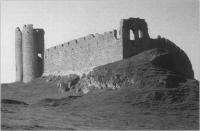
Castle Roche, County Louth, residence of Sir Thomas de Verdon, with whom Sweteman clashed. (OPW)
It was Milo Sweteman’s fate to follow in the footsteps of men more memorable than himself. He came from English settler stock in Kilkenny and was probably still a child in the 1320s when his bishop and future patron, Richard Ledred, ripped local colonial society asunder by instigating the trial of Alice Kytler on charges of witchcraft (See HI Winter 1994). Ledred finally expired in 1360 at the age of almost one hundred and the cathedral chapter elected Milo, who was by then treasurer of the diocese of Ossory, as his successor. He travelled to Rome for confirmation of his appointment only to find that in the meantime Pope Innocent VI had appointed the English Dominican, John Tatenhall, to the bishopric. Instead the pope provided Milo to the archbishopric of Armagh, vacant since the death of Richard Fitz Ralph in the same year. Former chancellor of Oxford University, teacher of Wycliffe and scourge of the Franciscans, Fitz Ralph was the most outstanding churchman Ireland had produced since Malachy. Filling his shoes would have been difficult in the best of circumstances, but to make matters worse Fitz Ralph had also been a local man, having been born and reared in Dundalk. His ferocious criticisms of his own people while archbishop were probably tolerated because of this local association; such forbearance was unlikely to be extended to an outsider.
Milo was consecrated in November 1361 and received the temporalities of the archdiocese from the king of England in February of the following year. His experience of settler feuding and English-Irish conflict in the turbulent Kilkenny region—vividly portrayed in the contemporary Kilkenny chronicle attributed to the Franciscan John Clyn—may have prepared him to some extent for what lay ahead in Armagh, but the challenges he faced in his new position remained daunting. Some of his own priests, for instance, were disaffected and in 1363 the cathedral chapter at Armagh elected the bishop of Raphoe, Pádraig Mac Maonghail, as archbishop on the grounds that the see was destitute of a pastor. Nothing came of this, but Milo had on more than one occasion thereafter to defend himself against malicious charges about his conduct brought before the pope by his own clergy. On another front he was forced to fight long and hard to have his position as head of the Irish Church recognised against the counter-claims of the archbishop of Dublin. Milo did not live to see Armagh’s final victory in this contest and its consequence for his own career was in effect to sideline him politically, as he refused to enter the ecclesiastical province of Dublin—wherein, of course, lay the centre of English power in Ireland—unless his ecclesiastical primacy was recognised.
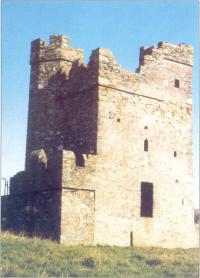
Tower house at Termofeckin, County Louth – Sweteman divided his time between here and Dromiskin. (OPW)
Frontier society
The division of Ireland into areas settled by the English and those controlled by the Irish was firmly established by the fourteenth century and dictated the character of the Irish Church. The English-controlled diocese of Meath, for instance, never saw an Irish bishop after 1200, while Raphoe or Derry never saw an English one. The situation in the diocese of Armagh was particularly complex as it contained within it areas of both English and Irish control. In the south, County Louth was solidly English, while in the north—which included the cathedral city of Armagh itself—power lay with the Uí hAnluain and behind them their more powerful sponsors the Uí Néill. Milo lived among the English of Louth, dividing his time between his two manors of Dromiskin and Termonfeckin, and acted as an important font of patronage for members of the local gentry who served in his household and received from him land and wardships as well as appointments to act as his attorney or attend parliament on his behalf.
Relations with the local settler elite were not always smooth. Milo clashed dramatically, for instance, with perhaps the most powerful man in the county, Sir Thomas de Verdon. Milo was dining with one of his suffragan bishops one Saturday evening in the summer (the year, unfortunately, is impossible to determine) when news came that de Verdon and others had broken into a church and stolen a box containing the Eucharist. Milo immediately went to the scene to interview witnesses and pronounced de Verdon heretical in his court on the following Monday. Sir Thomas went to Termonfeckin the next day and found the archbishop in his chapel. Milo again pronounced him heretical, whereupon Thomas replied, Et ego, Thomas de Verdon, te pronuncio et denuncio hereticum [And I, Thomas de Verdon, pronounce and denounce you a heretic]. In such unrestrained behaviour Thomas was following a family tradition—his father and uncle had entered into full-scale rebellion against the Crown in Louth earlier in the century—but none of his ancestors had gone so far as to excommunicate an archbishop. Milo seems to have succeeded in facing down de Verdon, but the incident revealed the propensity for violent conduct which characterised this frontier society.
Across the frontier, in the areas controlled by the Irish, Milo faced a world very different from his own. In purely ecclesiastical terms the Irish church operated without a parochial structure while recognising types of clergy, the comharbaí and airchainnigh, which were unknown elsewhere in Christendom. Even more exotically, far to the north-west in the Irish-controlled diocese of Clogher lay the famous and mysterious pilgrimage centre of Patrick’s Purgatory on Lough Derg. In 1366 Milo commended to the hospitality of the prior of the site two Italian pilgrims who were anxious to experience its penitential rigours. As if managing the frontier between the English and the Irish was not enough, Milo also found himself in charge of the physical frontier between this world and the next.
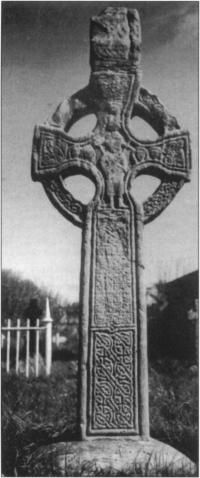
High Cross at Termonfeckin. (OPW)
Incest and adultery
The Irish bishops in the province of Armagh were more often than not members of the local ruling secular dynasty, and their grasp of the responsibilities which episcopal office entailed was often tenuous. The most notoriously lax of Milo’s suffragan’s was Riocard Ó Raghallaigh, bishop of Kilmore, whom Milo excommunicated in 1366 on charges of incest and adultery with his first-cousin. Enforcing such sentences in areas where English power did not hold sway was far from easy and in this case Milo eventually called upon the king of Breifne, Pilib Ó Raghallaig—a kinsman of Riocard’s—to remove the bishop. Riocard subsequently wrote to Milo to complain that he had been despoiled by Pilib, to which Milo replied that it was entirely his own fault as he had been living in mortal sin for years.
In this instance Milo’s invocation of the lay power among the Irish to enforce his decision had proved successful, but there were great risks to such a policy as he discovered in his dealings with the most powerful dynasty of his province, the Uí Néill. In 1376 Niall Ó Néill informed the archbishop of a conspiracy against him by members of his cathedral chapter and as a reward Milo made him his arch-seneschal, which entitled Niall to collect rents from the archbishop’s lands among the Irish. Having gathered the money, however, Ó Néill proceeded to keep it for himself and announced ‘like some pope or emperor’ that he would take all of the archbishop’s lands into his own hands. Milo had been double-crossed and there was little he could do about it. His occasional threats to use the power of the English Crown against his Irish enemies were treated by them with appropriate scepticism, and his frequent deployment of the spiritual weapon of excommunication was of limited value. As Milo once wearily observed in connection with Ó hAnluain, he had excommunicated him many times ‘whereupon he behaved worse than before’.
Condoned use of the hunger-strike
The archbishop did avail of one very interesting device to gain compensation from his persecutors. In 1365 he wrote to Conor Ó Maolchallann, whose family were hereditary keepers of the bell of St Patrick, giving him permission to fast upon those who molested the archbishop’s tenants. In other words Milo condoned the use of the ancient Irish custom of hunger-striking to secure restitution for the Church. This is not the only evidence which suggests that Milo was at ease with Irish customs and expressions of spirituality. Christianity, after all, was already nine
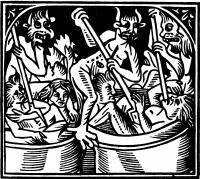
Patrick’s Purgatory – the torment of the cauldron, Le voyage de puys sainct Patrix auquel lieu on voit les penies de purgatoire et aussi les ioues de Paradis (Claude Noury, Lyon 1506)
hundred years old in Ireland by the time he became archbishop, whereas the English had only been in the country two centuries, and Milo was
at pains to stress that he was the successor of St Patrick and carried before him the very same cross which Patrick had carried. The native legacy was everywhere to be seen, even in the parts of the diocese which were among the English (inter Anglicos). A few miles from Milo’s manor of Termonfeckin was the ancient Irish monastery of Monasterboice with its high-cross and round tower, while the churches of both Termonfeckin and Dromiskin (Milo’s other manor) were dedicated to sixth-century Irish saints; respectively Fechin and Ronan.
Albrecht Suurbeer, the German archbishop of Armagh, wrote in the 1240s that the English and Irish persecuted each other ‘with an insatiable hatred’, while a century later Richard Fitz Ralph told the pope that ‘the two nations are opposed to each other with a traditional and inborn hatred’. The archbishop of Armagh was uniquely placed to arbitrate between the two sides in his province and was frequently called upon to do so. Although Milo belonged to the colonial community—he would never have become archbishop had he been Irish—he was at pains to show himself impartial between the two nations. He frequently made the dangerous journey to his cathedral city of Armagh and employed Irish clergy in the most important and sensitive posts, even choosing Odo Mac Diomáin, chancellor of Armagh, to act as his representative at the Roman curia.
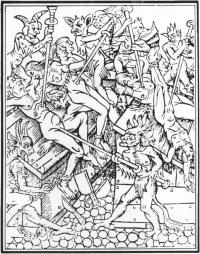
Patrick’s Purgatory – the torment of the nails, Le grand calendier et compost des Bergiers compose par le bergier de la Grand Montagne.(Jean Cantarch, Lyon 1551)
Arbiter between Irish and English
It is impossible to know whether such a balanced approach on Milo’s part helped defuse potential conflict, but it is clear that the most important Irish leaders in Ulster—despite their habitual encroachments on church property—did respect and trust the archbishop and were prepared to avail of his mediating services. In July 1373, for instance, Milo negotiated a concordat between Ó Néill, Mac Aonghusa, Mac Mathghamhna and Mac Domhnaill on the one hand and the leading English families of Louth on the other whereby they agreed in future to appeal to him for judgement when disputes arose instead of rushing instantly to war. Both sides swore to this on the cross of St Patrick, one of the most sacred relics of medieval Ireland, but mistrust between the parties ran deep and in the November of the following year Ó Néill wrote to Milo to inform him that the English of Dundalk had broken the peace. Shortly afterwards the Irish launched one of the most devastating raids of the fourteenth century into Louth, killing the sheriff and several other notables in the process. In this instance Milo’s peace-making efforts had failed, but it is likely that without them the level of violence in this divided society would have been even higher, and he seems to have had a reputation among his successors as one who strove for concord. Later medieval archbishops paid tribute to Sweteman by regularly reissuing the following decree which they attributed to him:
Under penalty of excommunication for disobedience, each of our suffragan bishops should work to the best of his ability to bring about, maintain and conserve the peace between the English and Irish of our province of Armagh and preach peace between them. If anyone of these bishops should be a sower of discord between English and Irish he shall be excommunicated ipso facto.
We know so much about Milo and his career as archbishop of Armagh because of the survival of his register, which contains copies of the letters he sent and received as well as many other interesting documents. The register as it now stands—it is kept in the Public Record Office, Northern Ireland in Belfast—is much less complete than it was in Milo’s day and in chronological terms is very uneven (almost half of what survives deals with the years 1365-7, for instance, while the decade 1371-1380 is the concern of only a handful of entries). Given the spectacular rate of document destruction in Irish history, however, we can only be grateful that so much has survived. Milo’s register is the earliest extant Irish episcopal register and begins a series of such collections for Armagh—the only diocese for which any registers survive—which stretches almost unbroken into the sixteenth century. To date only one of these registers, that of John Mey, archbishop of Armagh 1443-1456, has been published, but the Irish Manuscript Commission expects the appearance in print of Milo Sweteman’s register to initiate the publication of the rest of the series.
Brendan Smith lectures in medieval history at the University of Bristol.
Further reading:
J.A. Watt, The Church in Medieval Ireland (Dublin 1972).
K. Walsh, A Fourteenth-Century Scholar and Primate: Richard Fitz Ralph in Oxford, Avignon and Armagh (Oxford 1981).
A. Cosgrave, Late Medieval Ireland, 1370-1541 (Dublin 1981).
















